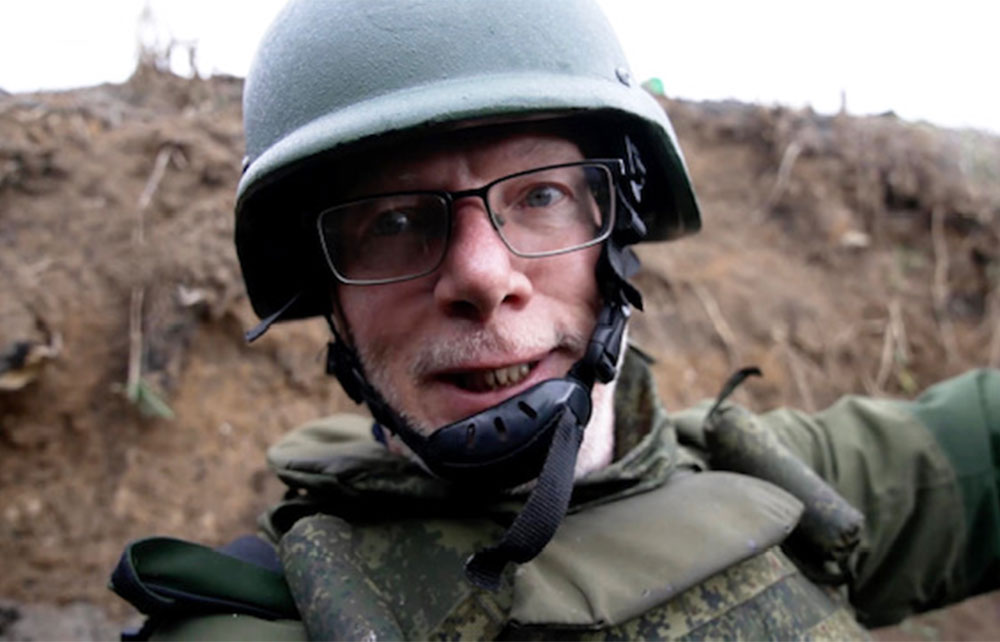My oldest friend, Sean Langan, was back in the news this week. He’s carved out a niche for himself as a maker of low-budget documentaries in conflict zones and his most recent film was shown on ITV on Monday night. He keeps costs down by shooting them himself on a hand-held camera, which isn’t easy given that he also stars in them. This involves holding a camcorder at arm’s length and pointing it at himself as he wanders through some of the world’s most dangerous hot spots, often in the midst of explosions and gunfire.
He’s paid a heavy price for being a war correspondent with his finances suffering and even losing several teeth
The fact that he’s a one-man band means he’s able to make films in places few other documentary–makers can reach. It sounds amateurish and in a way it is, but the unvarnished nature of the footage makes for a raw, immersive experience. His 2001 BBC2 series Langan Behind the Lines was nominated for a Bafta and last year he won the James W. Foley World Press Freedom award.
This latest venture is called Ukraine’s War: The Other Side and it finds him on the Russian-occupied eastern front, the first time a British or American professional journalist has gained such access. In one scene, he stumbles across a cache of captured Nato weapons in a barn, only to be surprised by a group of masked Spetsnaz operatives who have come to help themselves to the contraband. ‘Who let this foreigner in?’ asks one. ‘All hell is going to break loose now. I’m going to eat his liver.’ Sean, who doesn’t speak Russian, turns to Sasha, his fixer, to translate. After he’s done this, Sasha adds: ‘Try not to irritate these guys.’
Most journalists would think ‘time for a sharp exit’, but not Sean. He starts asking them questions, particularly after he discovers they’ve just been kicked out of Kherson, a city occupied by Russian forces between March and November 2022. Do they know anything about the torture chambers discovered by the Ukrainians? Instead of getting more and more irate, the Russian commandos warm to him and start trotting out bizarre justifications for the ‘special military operation’. ‘Study the Russian history carefully and you will understand that the Russians never wanted war,’ says the leader of the group. ‘The Russians don’t attack. The Russians end wars.’
Footage like this has attracted criticism from some pro-Ukrainian British politicians, who claim it’s irresponsible of ITV to broadcast it, particularly in the wake of Alexei Navalny’s murder. ‘I don’t think this documentary should be shown,’ Lee Anderson told the Mail. ‘At a time when the whole world is trying to help Ukraine in this difficult time, we need the support of the British public.’
But as someone who’s fanatically pro-Ukraine, I don’t think this film will jeopardise public support. On the contrary, the Russian apologists for Vladimir Putin in the documentary sound as deluded as the Spetsnaz commander banging on about the need to protect Russian-speaking Ukrainians from ‘Nazis’ and ‘perverts’. In addition, Sean makes no bones about which side he’s on – although, understandably, he’s done that in a voiceover recorded back in London.
Sean’s journalistic technique is to draw out his subjects by posing as utterly guileless – almost as if Mr Magoo had stumbled into a war zone. As an interviewer, he’s the opposite of Jeremy Paxman, lulling people into a false sense of security by smiling and making self-deprecating jokes. Sometimes he asks sworn enemies of the West if they can help him shoot some B-roll and we watch as hardened terrorists become amateur cameramen. This routine doesn’t always guarantee his safety – he was kidnapped by a Taliban warlord in Pakistan – but mostly it does. The propagandists for authoritarian regimes mistake him for a useful idiot and let their guard down. Only later do they discover that he’s actually a very dangerous idiot.
I helped Sean get his first job in journalism, having become friends at school, and to begin with he ploughed the same furrow as me. But in 1989 he headed to eastern Europe to cover the collapse of the Soviet Union and our paths diverged. Since then he’s paid a heavy price for being a war correspondent, with his marriage ending, his finances suffering, and even losing several teeth as a result of being held hostage in a windowless cell for several months. But even though I’m happily married and have all my teeth, I will never win any glittering prizes, whereas Sean already has. Ukraine’s War: The Other Side is his finest work and I’ll be astonished if it doesn’t win a Bafta. Chapeau, old friend.
Ukraine’s War: The Other Side is available to watch on ITVX.







Comments